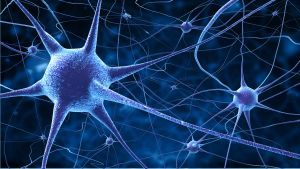Supporting the regeneration of nerve cells with chitosan

Worldwide, about 2.5 million people live with the consequences of a traumatic spinal cord injury. At the injured site formation of glia scar tissue prevents the regeneration of nerve cells. To date, complete functional recovery of the spinal cord is impossible, also because the cascade of events that takes place at the injured site is not fully understood yet.
Chitosan-based hydrogel to support the paracrine activity of mesenchymal stem cells in spinal cord injury treatment
M. Boido, M. Ghibaudi, P. Gentile, E. Favaro, R. Fusaro, C. Tonda-Turo. Scientific Reports, volume 9, Article number: 6402 (2019)
The treatment methods currently being intensively researched are based on porous 3D scaffolds for bridging the injured site and local release of drugs, signaling molecules or cells. In this study, published in Nature Scientific Reports researchers from Italy and the UK developed chitosan-based hydrogels with encapsulated mesenchymal stem cells (MSCs). Previous studies have shown that the paracrine action of MSCs improves the regeneration of spinal cord injury, limits the formation of glial cells and reduces cell death at the lesion. The use of hydrogels as scaffold improves the chances of survival of the transplanted cells, as they are encapsulated, releasing their signal molecules locally at the site of the injury.
The researchers manufactured an injectable and hightly permeable hydrogel based on chitosan, which had a rapid gelation at temperature rise from 0 to 37°C. For the hydrogel chitosan 95/100 (degree of deacetylation [%] / viscosity [mPas]) by Heppe Medical Chitosan GmbH was applied. As crosslinking agent β-glycerophosphate disodium (β-GP) was used. The final concentration of chitosan/β-GP was 2.5 % (w/V) and a pH of 7.11±0.03. The MSCs were mixed with the chitosan hydrogel shortly before gelation. Gelation time, morphology, injectability, stability and permeability of the chitosan hydrogel were tested. The mesenchymal stem cells were isolated from two-month-old male mice and their viability was examined in the presence of the hydrogels. Feasibility was examined in vivo with 3 mice, which underwent surgery. Spinal cord transection was performed and the chitosan/β-GP hydrogel with MSCs was injected immediately at the lesion site. One week later, the tissue was examined.
Results
- the chitosan hydrogel had no negative effect on the MSCs viability
- encapsulated MSCs released extracellular vesicles with signaling molecules
- paracrine action and anti-oxidative effect were preserved
- in vivo experiments in mice after spinal cord injury showed
- a good handling of the MSCs-loaded chitosan hydrogels during implantation
- a high survival rate for the encapsulated MSCs
Conclusion: The use of biomaterials as a scaffold for stem cell therapy is a promising strategy to solve medical problems like the treatment of spinal cord injury. Chitosan hydrogels are biocompatible, easy to process and provide an optimal physiological environment for viable cells, offering great potential as substrate for MSC-based therapies. The paracrine action of MSCs could also be used for treatment of other diseases affecting the nervous system.
In the second article, researchers from Poland and France investigated a chitosan lactate-based hydrogel implant in rats with spinal cord injury.
Thermogelling chitosan lactate hydrogel improves functional recovery after a C2 spinal cord hemisection in rat.
K. Nawrotek, T. Marqueste, Z. Modrzejewska, R. Zarzycki, A. Rusak, P. Decherchi. J Biomed Mater Res A. 2017 Jul; 105 (7):2004-2019. doi: 10.1002/jbm.a.36067. Epub 2017 Apr 12.
The authors produced a cross-linked hydrogel of chitosan (degree of deacetylation 80%, Sigma-Aldrich) and lactic acid, which undergoes gelation at temperatures of 37 ° C or greater. In this case, the porous structure of the hydrogel allowed the ingrowth of glial and axon cells. In vitro, the toxicity of the chitosan lactate hydrogel was tested with fibroblast cells. In addition, the hydrogel was implanted in rats that had undergone C2 spinal cord injury.
The animals were divided into three experimental groups (control (n = 6), lesion (n = 7), lesion + hydrogel (n = 13)) and examined once a week over a period of 10 weeks using a variety of functional tests. A ladder climbing test, a forepaw grip strength test and a whole-body plethysmography were performed. In addition, neurophysiological changes were examined 10 weeks after the operation using electrophysiological examinations (Hoffmann reflex) and adaptation of breathing in case of temporary hypoxia.
Results
- in vitro: chitosan lactate hydrogel is non-toxic for fibroblast cells
- in vivo: Lesion + hydrogel group compared to lesion group
- Ladder climbing test: better mobility of the forelimb after 4 weeks
- Hoffmann reflex: restoration of the H-reflex
- Better ventilation after electrically induced muscle fatigue
- Increase in the activity of the phrenic nerve in hypoxia
Conclusion: The study results showed that the use of chitosan lactate-based hydrogels for the treatment of spinal cord injuries improves the functional recovery of the central nervous system.
Would you also like to design and investigate chitosan-based hydrogels? Our chitosans with diverse specifications can you find here.


